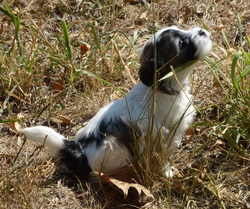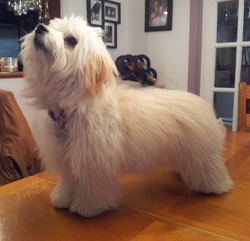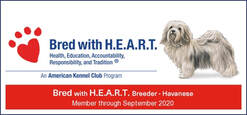General Questions & answers
1. Welcome! 2 Cute Havanese offers a variety of puppies.
2. Size. Our puppies generally range in weight from 8-14 lbs. We do not guarantee weight, size or color.
3. 'Sable'. The color 'sable' normally means 'brown'. In Havanese speak 'sable' means 'change'. Havanese can vary in their coloring some throughout their life but 'sable' puppies can change dramatically. See 'Color Changes' page. A wonderful detailed page beyond ours is Colours of the Rainbow (https://havaneseabc.com).
4. Affection. With Havanese the male is often more affectionate that the female. An example is when called, the male will come right away where the female will give it a moment's thought.
5. Introduction to an existing dog. If you have a dog at home please give them time to adjust to the new puppy. Be sure to show attention to your existing dog more than usual. For instance over the next couple of months always pick your existing dog up first, treat that dog first, give them extra attention, etc. The puppy absolutely will not care but your existing dog will and may get jealous or act out.
6. Temperament or Personality. A working dog as a puppy is not given a temperament test until about 10 weeks of age. We have seen puppies shift from being very laid back to very active. We encourage you to examine your lifestyle to know if you want an active vs. a less active puppy or in between. We can offer our opinion if asked.
7. Socialization. Puppies have a huge window from 2-4 months to be socialized. Of course socializing starts from day 1 and will continue past 4 months of age but this window is an important time to push for learning experiences for them. Unfortunately this window coincides with protecting them from parvo, too. In our book we have a Socialization Scavenger Challenge and more for you and your puppy.
8. Parvo. Parvo and Distemper are two of the greatest threats for any puppy. Parvo can live on inanimate objects such as a shopping basket in a pet store or your shoes for 48 hours. Distemper lives on inanimate things for 24 hours. Both are extremely contagious. Parvo is a 10-14 day roller coaster that many puppies do not survive. We are very clear about waiting to visit us 48 hours after going to a pet store, another breeder's home, dog park or veterinarian office. Older dogs can carry and shed the virus without knowing it.
9. School. We recommend you take your puppy to a 'Puppy Manners' class about 2 weeks after 3rd shots. Puppies do grow up and on the way to becoming an adult dog they go through adolescence when they forget all the good things you taught them including, sometimes, who is the boss.
10. Feeding. We 'free' feed. Food and water are available during the day. Havanese have a high metabolism and nibble on a couple kibbles at a time all day long. See your binder for more information.
11. Puppy Pick Up. All puppies have seen the veterinarian twice and have been examined twice. The first time is to remove dew claws and the second time is for the first puppy shot and to get their micro-chip (@ 8 weeks). The pups also have a 'stinky' (Mom) toy, a book written about them for you and bag of food. See 'Getting Your Havanese' page.
12. Potty Training. Puppies have been introduced to a grass mat or a pee pad and their potty training has begun. It is not rocket science but it does take time over the first few days beginning with your discipline to see it through. About every 2-3 hours, after a nap, first thing in the morning or before bedtime take the dog out and show the pup where you want it to potty. Praise, treat! Expect boo boos. Consistency counts.
13. Puppy Wish List. See the 'STEPS TO BUY, WAITING LIST & DEPOSIT' page under 'Puppy Preparation. Please ask any questions.
14. Veterinarians. We strongly encourage you to find the best veterinarian near you with his/her name on the door. Open on Saturdays. No corporate/chain veterinarians.
15. Full Immunization. Your puppy is fully vaccinated at 17 weeks. The shot schedule is 8, 12, and 16 weeks. It takes a few days after the last shot for full immunization against parvo & distemper to effective. Rabies vaccination is given usually about 16 weeks. Allow 17 weeks before you expose your puppy to any public dog areas, pet stores or access to any area outside a secured yard area.
16. Deposit. Deposits are non-refundable but will roll over litter to litter until you find the pup you want. Please see Waiting List & Deposit page for more information.
17. Spaying/Neutering. All puppies are sold on a spay/neuter contract. We recommend the males be neutered as late as your veterinarian advises to allow muscle mass and bone growth to develop as much as possible (8 mos. +). We also recommend the females wait as long as possible to support time for bone growth. Please read the insert in the book.
18. Children 3-9. Havanese are wonderful with children but as puppies they need their human mom's and dad's help. They are babies, too, for a while and need all their family to understand they need to take naps and limited play time with a small child. Getting a small child a stuff toy dog to practice picking up a pup with two hands and placing four feet on the ground when setting down before the puppy comes home and just sitting on the ground with a puppy may be helpful. Puppies love children but need supervision with love for all. In the book there are a few pages with recommendations especially for a small child with a new puppy. We believe a puppy can be a child's first best friend.
19. The Right Fit. We are seriously concerned about the 'Right Fit' for you and your family. To that end we encourage and welcome continuing questions before and after the sale. We retain the right to refuse any sale. Folks who have not had a dog before may find themselves in a quandary over something a simple call to us may solve. We definitely talk "Havanese"!
20. CDPA Testing - In the article ‘Breed Defining Chondrodysplasia’ by Julia Bouirmane in My Dog DNA, she explains CDPA as a “desirable trait”. UC Davis Veterinary Genetics Laboratory (VGL) comments on breeders “retaining the short-legged phenotype conferred by CDPA” in the Havanese Health Panel documentation. This is the very short version of information found in the longer 2CH article about CDPA found in Kiwi’s Korner.
Quotes:
“In breeds where both mutations are present, breeders can benefit from test results to implement breeding strategies to reduce incidence of CDDY, while retaining the short-legged phenotype conferred by CDPA.” – UC Davis Havanese Panel. https://vgl.ucdavis.edu/services/dog/HavanesePanel.php
“Breed-defining chondrodysplasia, also called short-leggedness, is a favorable phenotype found in some breeds [Havanese] . . . Short-leggedness caused by the FGF4 insertion is a desirable trait, and it is caused by different mutation than the undesired dwarfism causing genetic disorder found in some breeds, such as the Norwegian Elkhound.” From the article ‘Breed Defining Chondrodysplasia’ by Julia Bouirmane in My Dog DNA -https://mydogdna.com/blog/breed-defining-chondrodysplasia
2. Size. Our puppies generally range in weight from 8-14 lbs. We do not guarantee weight, size or color.
3. 'Sable'. The color 'sable' normally means 'brown'. In Havanese speak 'sable' means 'change'. Havanese can vary in their coloring some throughout their life but 'sable' puppies can change dramatically. See 'Color Changes' page. A wonderful detailed page beyond ours is Colours of the Rainbow (https://havaneseabc.com).
4. Affection. With Havanese the male is often more affectionate that the female. An example is when called, the male will come right away where the female will give it a moment's thought.
5. Introduction to an existing dog. If you have a dog at home please give them time to adjust to the new puppy. Be sure to show attention to your existing dog more than usual. For instance over the next couple of months always pick your existing dog up first, treat that dog first, give them extra attention, etc. The puppy absolutely will not care but your existing dog will and may get jealous or act out.
6. Temperament or Personality. A working dog as a puppy is not given a temperament test until about 10 weeks of age. We have seen puppies shift from being very laid back to very active. We encourage you to examine your lifestyle to know if you want an active vs. a less active puppy or in between. We can offer our opinion if asked.
7. Socialization. Puppies have a huge window from 2-4 months to be socialized. Of course socializing starts from day 1 and will continue past 4 months of age but this window is an important time to push for learning experiences for them. Unfortunately this window coincides with protecting them from parvo, too. In our book we have a Socialization Scavenger Challenge and more for you and your puppy.
8. Parvo. Parvo and Distemper are two of the greatest threats for any puppy. Parvo can live on inanimate objects such as a shopping basket in a pet store or your shoes for 48 hours. Distemper lives on inanimate things for 24 hours. Both are extremely contagious. Parvo is a 10-14 day roller coaster that many puppies do not survive. We are very clear about waiting to visit us 48 hours after going to a pet store, another breeder's home, dog park or veterinarian office. Older dogs can carry and shed the virus without knowing it.
9. School. We recommend you take your puppy to a 'Puppy Manners' class about 2 weeks after 3rd shots. Puppies do grow up and on the way to becoming an adult dog they go through adolescence when they forget all the good things you taught them including, sometimes, who is the boss.
10. Feeding. We 'free' feed. Food and water are available during the day. Havanese have a high metabolism and nibble on a couple kibbles at a time all day long. See your binder for more information.
11. Puppy Pick Up. All puppies have seen the veterinarian twice and have been examined twice. The first time is to remove dew claws and the second time is for the first puppy shot and to get their micro-chip (@ 8 weeks). The pups also have a 'stinky' (Mom) toy, a book written about them for you and bag of food. See 'Getting Your Havanese' page.
12. Potty Training. Puppies have been introduced to a grass mat or a pee pad and their potty training has begun. It is not rocket science but it does take time over the first few days beginning with your discipline to see it through. About every 2-3 hours, after a nap, first thing in the morning or before bedtime take the dog out and show the pup where you want it to potty. Praise, treat! Expect boo boos. Consistency counts.
13. Puppy Wish List. See the 'STEPS TO BUY, WAITING LIST & DEPOSIT' page under 'Puppy Preparation. Please ask any questions.
14. Veterinarians. We strongly encourage you to find the best veterinarian near you with his/her name on the door. Open on Saturdays. No corporate/chain veterinarians.
15. Full Immunization. Your puppy is fully vaccinated at 17 weeks. The shot schedule is 8, 12, and 16 weeks. It takes a few days after the last shot for full immunization against parvo & distemper to effective. Rabies vaccination is given usually about 16 weeks. Allow 17 weeks before you expose your puppy to any public dog areas, pet stores or access to any area outside a secured yard area.
16. Deposit. Deposits are non-refundable but will roll over litter to litter until you find the pup you want. Please see Waiting List & Deposit page for more information.
17. Spaying/Neutering. All puppies are sold on a spay/neuter contract. We recommend the males be neutered as late as your veterinarian advises to allow muscle mass and bone growth to develop as much as possible (8 mos. +). We also recommend the females wait as long as possible to support time for bone growth. Please read the insert in the book.
18. Children 3-9. Havanese are wonderful with children but as puppies they need their human mom's and dad's help. They are babies, too, for a while and need all their family to understand they need to take naps and limited play time with a small child. Getting a small child a stuff toy dog to practice picking up a pup with two hands and placing four feet on the ground when setting down before the puppy comes home and just sitting on the ground with a puppy may be helpful. Puppies love children but need supervision with love for all. In the book there are a few pages with recommendations especially for a small child with a new puppy. We believe a puppy can be a child's first best friend.
19. The Right Fit. We are seriously concerned about the 'Right Fit' for you and your family. To that end we encourage and welcome continuing questions before and after the sale. We retain the right to refuse any sale. Folks who have not had a dog before may find themselves in a quandary over something a simple call to us may solve. We definitely talk "Havanese"!
20. CDPA Testing - In the article ‘Breed Defining Chondrodysplasia’ by Julia Bouirmane in My Dog DNA, she explains CDPA as a “desirable trait”. UC Davis Veterinary Genetics Laboratory (VGL) comments on breeders “retaining the short-legged phenotype conferred by CDPA” in the Havanese Health Panel documentation. This is the very short version of information found in the longer 2CH article about CDPA found in Kiwi’s Korner.
Quotes:
“In breeds where both mutations are present, breeders can benefit from test results to implement breeding strategies to reduce incidence of CDDY, while retaining the short-legged phenotype conferred by CDPA.” – UC Davis Havanese Panel. https://vgl.ucdavis.edu/services/dog/HavanesePanel.php
“Breed-defining chondrodysplasia, also called short-leggedness, is a favorable phenotype found in some breeds [Havanese] . . . Short-leggedness caused by the FGF4 insertion is a desirable trait, and it is caused by different mutation than the undesired dwarfism causing genetic disorder found in some breeds, such as the Norwegian Elkhound.” From the article ‘Breed Defining Chondrodysplasia’ by Julia Bouirmane in My Dog DNA -https://mydogdna.com/blog/breed-defining-chondrodysplasia






